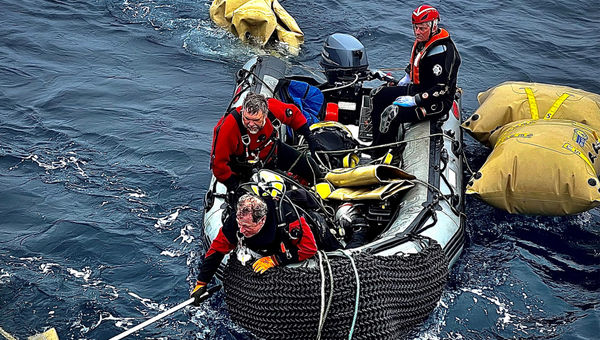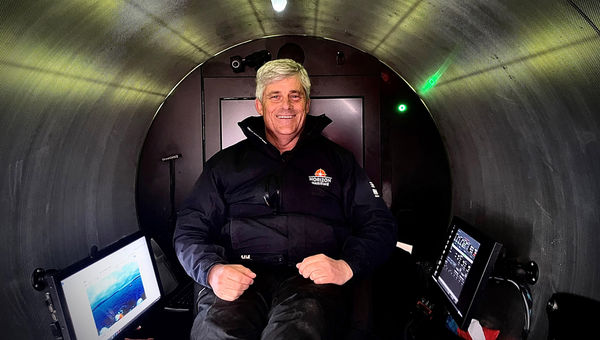Travel Weekly editor in chief Arnie Weissmann joined an OceanGate Expeditions mission to the Titanic wreck in May, a month before its submersible, the Titan, disappeared on a similar itinerary. Read Part 1 and Part 2 of his experience.
Wind, swells and fog -- sometimes present, sometimes predicted -- were the stated reasons dive days were canceled on my trip with OceanGate in May. But when I was onboard the support ship the Polar Prince and hoping to go down in the submersible Titan to see the Titanic, I sometimes wondered whether the submersible's readiness was also an unspoken, but important, consideration.
Protocols for dives were linked to a number of factors which, if they reached a certain threshold, automatically triggered a cancellation. Among them were conditions that were considered noncritical factors, such as wind more than 10 knots, a team member who was new to staff, or a celebrity or member of media on the dive as a mission specialist. (Mission specialist is OceanGate's name for a nonstaff guest like me).
That last one gave me pause. If the decision were one factor shy of the no-go limit but someone other than me, a journalist, were coming aboard, would they go forward with a dive that would otherwise be canceled solely because a reporter was present?
But generally speaking, I was impressed by what appeared to be a risk-averse operation. "Everyone needs to keep their head on a swivel and their eyes wide open," Stockton Rush, OceanGate's CEO and designer and pilot of the Titan submersible, had said at a morning briefing.
Wearing personal protective equipment -- bright orange jackets, water-activated life vests, steel toe boots and helmets -- was the rule. Each morning, a long to-do checklist was shared with everyone, including mission specialists. I found it both reassuring and, sometimes, nerve-wracking to have a front row seat to watch how the sausage is made.
But each daunting-sounding task was balanced by a sense that care was being taken. When Rush was giving out assignments at the briefings, if a repair was complex, he would tell the people working on it to "do a stopski" for five minutes when they were done. That meant that, before they left the task, they should pause for five minutes and think about everything they did, make sure it was done correctly and confirm that they weren't missing anything.
Badly wanting to go on a dive, I didn't always see why some factors were considered problematic. Initially, I was puzzled why surface conditions, a seven-foot swell, for instance, might be a reason to cancel a dive. Afterall, didn't the dive take place under the surface?
"The size of the swells matters," Rush said, and he told me why: To get to the sub, a boarding platform is lowered over the side of the Polar Prince. Mission specialists step from that platform onto an inflatable dinghy for the ride to the launch and recovery platform that holds the Titan submersible. When seas are high, that step is the most dangerous part of the entire process, he said: the sea could suddenly drop the dinghy seven feet in an instant, just as you're walking onto it.
A problem with Titan's platform
On the fourth day of the mission, when the seas were most active and fog was the thickest, a near-disaster for the sub and platform occurred: At the end of the rope that linked the stern of the ship to the platform, we saw that the front of the platform and the sub were underwater.
It wasn't clear why. A fishing buoy had been seen nearby just prior to the problem. It was hypothesized that a line from it had gotten tangled in the platform and tipped the front down, and the part of the platform that should have held air had become flooded.
And it was unclear how it could be raised. Rush huddled with his crew, and a large, red, inflated buoy was attached to the tow line connecting the ship with the platform. The hope was that the buoy would slide down the tow rope to the platform and provide lift to the front.
Rush and two other divers got in a dinghy and came to the stern of the ship where two large, yellow floatation bags were tossed down to them to add more lift.

Crew on a dinghy reach for equipment that might help raise the nose of the platform. OceanGate CEO Stockton Rush, in a black scuba suit, sits at the rear.
However, the front of the platform was so far under water that the buoy could not be forced under it and only the edges of the flotation bags could provide minimal lift.
The divers went under the platform and got the water out and the air back in, and it was once again level. The entire process took more than half the day.
When I asked how much jeopardy the sub was in, Rush joked, "So a sub is under water. Why is that a problem?"
No fishing line was discovered in the platform, though it may have done its damage and then untangled itself, Rush added.
What could go wrong?
I asked if anything concerned him about what could go wrong with the dive itself. He answered, "Ghost nets."
There's a lot of commercial fishing gear that gets loose, like the fishing buoy, and adds to the manmade items moving around the oceans. If an untended net should by chance be positioned above the submersible as it rises, it could keep it submerged, and there's not much the sub could do to free itself.
Wreck expert Paul-Henri "P.H." Nargeolet, who was also onboard, told me he wasn't worried about what would happen if the structure of the Titan itself were damaged when at the bottom of the ocean. "Under that pressure, you'd be dead before you knew there was a problem." He said it with a smile.
I asked why he kept returning to the wreck; his next dive would be his 38th. "Each time is totally different," he answered. "You always see things you've never seen before."
On day six of the mission, the dive window finally closed for good and the Polar Prince headed back towards St. John's, Newfoundland. I was disappointed, and Rush said we could stop in a protected bay along the way, and he'd take me and the other mission specialists down on a test dive to a depth of about 300 feet.
But I didn't even get that consolation dive -- the sub was being worked on that entire day. I did end up boarding a dinghy to go out to the platform to see the inside of the Titan for myself.
Just as I was leaving the Polar Prince for the sub's platform, the seas rose about six feet, and I was grateful for the lesson on how to time the swells to step safely off the ship and onto the dinghy.
Going inside the Titan
When I got to the platform, the side panels of the sub were up, and three crew members and the researcher were all busy working on different parts of the vessel. The researcher paused to show me how water samples are collected.
Waiting inside the sub itself was Rush, sitting cross-legged on the seating platform. He had a laptop beside him and showed how the pilot, with a gaming controller, would move the sub from side-to-side or up-and-down. He pointed out the toilet in front of the porthole and a screen in the aft that relayed images from the camera mounted outside the sub.

OceanGate CEO Stockton Rush sits inside the Titan.
There really wasn't much to see in the sub, and the tour didn't take long. Rush and I took some selfies, someone offered to take a photo of me from the outside with my face in the viewing porthole, and I got off the platform and returned to the ship.
Why would you dive to see Titanic?
Between the wind, waves, fog, platform issues (the platform and sub tipped on another day, though not as precariously and was righted more quickly), the knowledge that the sub was made from carbon fiber that could not be certified to be used on aircraft and with endless checklist items that needed to be tended, you might wonder why I was still willing to go on a dive if it were offered.
Reading that paragraph, I wonder myself. But the answer, in the moment, was the presence of P.H. Nargeolet. I felt that if such an experienced wreck diver and explorer, who had seen and understood so much more than I did, was comfortable going down in the Titan, then I could be, too.
On the first evening in St. John's, just after I met P.H. and we sat down for a drink together, I asked him why he was going. Rush, he said, "asked me to come dive to see the Titanic. I never find it a problem to say yes to that."
When I reconnected with Hamish Harding, who was also on the missing submersible, at the Explorers Club global conference on the Azores island of Terceira last week, he already knew I had been on the mission and hadn't made a dive.
He asked me for my impressions of the operation.
I told him candidly. He raised his eyebrows. I said that I thought many of the problems with my nondive may have arisen because this was the first season that the Titan was being towed behind its support ship rather than being kept on its deck. I said I thought the sub and platform were being tossed around pretty roughly on a daily basis.
But, a seasoned explorer, Harding didn't seem overly concerned. When I last saw him -- exactly one week ago -- he told me he'd be leaving the conference early the next morning to fly to St. John's to board the Polar Prince.
As I began writing this series, it was thought that the life support systems for Harding, Rush, Nargeolet and two other mission specialists were running critically low, but there was still some hope. I was still hoping for a miracle. The history of exploration has many examples of people who were thought to have perished but survived. (If you haven't read "Endurance," the incredible story of Antarctic explorer Ernest Shackleton, by Alfred Lansing, put it at the top of your list.) It was my hope that the story of OceanGate and the Titan would add another, similar chapter in the long history of exploration.
But as I finish this, search and rescue robots discovered a piece of the Titan on the ocean floor, indicating a catastrophic implosion and the loss of five lives, including three dedicated explorers I had come to know.
Read Part 1 and Part 2 of Arnie Weissmann's experiences with OceanGate Expeditions in May.